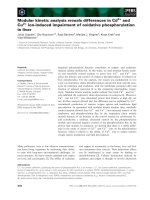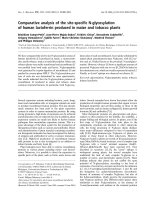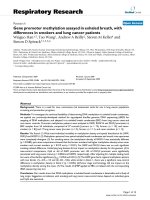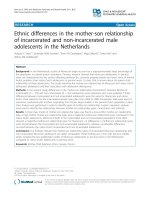Asexual morphological differences in male and female plants of Commiphora wightii (Arn.) Bhandari - An endangered medicinal plant
Bạn đang xem bản rút gọn của tài liệu. Xem và tải ngay bản đầy đủ của tài liệu tại đây (1.38 MB, 9 trang )
Research in Plant Sciences, 2017, Vol. 5, No. 2, 51-59
Available online at />©Science and Education Publishing
DOI:10.12691/plant-5-2-1
Asexual Morphological Differences in Male and Female
Plants of Commiphora wightii (Arn.) Bhandari - An
Endangered Medicinal Plant
Arti Gaur, Hema Singhal, U.K. Tomar*
Forest Genetics and Tree Breeding Division, AFRI, Jodhpur
*Corresponding author:
Abstract Studies were carried out on growth characteristics, stem branching pattern and leaf morphology to
reveal the significant differences in male and female plants and development of reliable morphological markers to
identify gender even in non-flowering phase. Female plants have spreading growth and weeping canopy whereas
male plants have erected growth and divergent canopy. Female plants have significantly higher height
(p = 0.06) and collar diameter (p = 0.03) than males. Similarly, female plants also have higher number of secondary
and tertiary branches with wider branch angles leading to the differences in canopy shape and size between two
genders. Other morphological differences observed in female and male plants are in leaf characters viz. leaf area,
leaf margin and number. Male plants were only having higher stomatal density (p = 0.03) on both the sides of leaves
as compared to females. Guggulsterone-Z was detected only in aerial branches of female plants (0.014-0.029%) and
in males it was below detectable limits.
Keywords: apomixis, branch angle, Burseraceae, endangered, guggul, sexual dimorphism, stomatal density
Cite This Article: Arti Gaur, Hema Singhal, and U.K. Tomar, “Asexual Morphological Differences in Male
and Female Plants of Commiphora wightii (Arn.) Bhandari - An Endangered Medicinal Plant.” Research in Plant
Sciences, vol. 5, no. 2 (2017): 51-59. doi: 10.12691/plant-5-2-1.
1. Introduction
Commiphora wightii (Arnott) is one of the important
traditional and endangered medicinal plants of semi arid
region of India [1]. It belongs to family Burseraceae. C.
wightii is also known as ‘guggal’ or ‘guggulu’ in hindi
and Indian bdellium tree in English ([2,3]). It is muchbranched perennial shrub/small medium-sized tree,
reaching to a height of 3-4 m [4]. It is distributed mainly
in the arid regions of Rajasthan, Gujarat, Madhya Pradesh,
Karnataka and Orissa states of India and also in the
adjoining areas of Pakistan [5].
It is basically used for its oleo-gum resin commonly
known as guggul gum which has been a key component in
ancient Indian ayurvedic system of medicine [6]. This is a
mixture of many important secondary metabolites mainly
E and Z-guggulsterones, which are of potent medicinal
uses mainly in arthritis, cold, bronchitis, laryngitis, obesity,
heart disease, lipid disorders etc. [7,8]. Encroachment,
unawareness of rural people, destructive harvesting
methods, unsustainable overexploitation and lack of
management cultivation practices led to decrease in its
population [9,10,11], as a result it has become threatened
species [12,13]. Thus the gap between supply and demand
of guggul gum is increasing rapidly. According to the
assessment reported by Ayurvedic Drug Manufacturing
Association (ADMA), less than 10% of requirement
of guggul gum is currently being met from indigenous
sources and remaining 90% of this material being obtained
through imports [14].
It is a polymorphic flowering plant having male,
female and andromonoecious type of plants [15].
Flowering occurs twice in a year i.e. in April/May and
October/November, rest of the year the plant remains in
vegetative phase. Male and andromonoecious plants are
extremely rare in natural population and plantations
[16,17]. In absence or scarcity of male plants, it evades the
process of fertilization and adopted apomixis for its
survival [16]. This situation may be leading the production
of genetically identical plants and loss of genetic variation
which may lead to genetic erosion of the species. Further
the breeding programmes and production of pure line and
homozygous plants would also get hampered in absence of
male plants. Thus, there is a need to identify extremely
rare male plants in natural habitats and conserve them for
future breeding programmes. Male and female plants can
be easily identified on the basis of flowers but difficult to
identify them during non flowering season.
RAPD molecular markers have been identified to
differentiate male and female plants [18] but it is very
expensive, time consuming and not very useful to a field
researcher. At the same time RAPD markers are also not
highly reliable. Therefore, present studies were conducted
with the aim to analyze mostly morphological, few
microscopic and Z- guggulsterone differences between
female and male plants. However, the main aim was to
develop morphological markers and distinguish male and
female plants during non flowering phase.
52
Research in Plant Sciences
2. Materials and Methods
Germplasm bank of C. wightii was established from 25
different districts of Rajasthan in 2007. In this germplasm,
two male plants were identified during flowering time.
Some distinct morphological differences in male and
female plants were also noticed in their form. Present
studies were carried out on 6-year-old two male (M1 and
M2) and three female (F1, F2 and F3) genotypes of
Commiphora wightii growing in this germplasm. Initially
these plants were irrigated for 1st & 2nd year and later these
plants were kept under natural conditions at the site.
Observations were taken in the mid of June 2013.
Minimum average temperature was 29.8°C, maximum
average temperature was 41.5°C, relative humidity I was
61% and relative humidity II was 32%. The annual rainfall
for that year was 575 mm.
2.1. Morphological Parameters
Thirteen qualitative and quantitative morphological
parameters under three categories i.e. growth characteristics,
leaf morphology and branching pattern of the plant were
studied. Growth habit, canopy, plant shape, stem bark
color, leaf shape and margin were qualitative and height,
crown, number of branches, branch angles, number
of leaves, leaf length and leaf area were quantitative
parameters.
(A) Growth characteristics: Plant shape, height,
canopy, growth habit, and crown size were observed as
growth characteristics. The overall shape, growth and
canopy of the plant were evaluated visually on the basis of
standard terminology used in taxonomy. Plant height was
measured in cm from ground adjacent to the stem to the
tip of leading branch of plant using graduated pole.
Average crown spread was measured in cm using cross
method of two longest spread at right angle and average
of these two readings was considered as crown diameter
[19].
(B) Branching pattern: Number of branches and
branching angles were measured to study branching
pattern. The numbers of branches of each genotype were
counted at three different levels viz. primary, secondary
and tertiary. The branching angles were evaluated using
divider and compass at all the three different orders. First
order (I) is the branching angle between primary and
secondary branches, II order is the branching angle
between secondary and tertiary branches and III order is
the branching angle between tertiary and quaternary
branches. Stem bark color was assessed visually of the
same diameter stem, from almost similar location of every
plant for the comparison.
(C) Leaf morphology- Data were recorded on shape,
margin, size, number and area of leaf. To evaluate leaf
shape and margins. ten fully expanded matured leaves
from each genotype were taken and assessed visually to
evaluate leaf shape. Leaf length of ten fully mature leaves
from each genotype was measured using measurement
scale. To count the number of leaves three apical twigs
(15 cm long) were collected from each plant and leaves on
each twig were counted excluding the small leaves at the
top of the twig. Leaf area was also calculated using graph
paper method [20].
2.2. Stomatal Studies
Microscopic studies were also conducted on stomatal
density, stomatal index and stomata types. Fresh mature
leaves of all the genotypes were collected, washed and
dried before removing epidermal layers. To peel the
epidermal layer method was adopted from TIEE [21].
Counting of stomata was performed on both adaxial and
abaxial epidermal layer of each genotype in 3 different
microscopic fields. An average no. of stomata and
epidermal cells per microscopic field (400X magnification)
were calculated and stomatal index was calculated using
the equation of Salisbury [22].
Stomatal index =
no. of stomata X 100
no. of stomata + no. of epidermal cell
Stomatal density was also determined by calculating
number of stomata per mm2. The number of stomata
present in a particular area of a grid was counted using
motic image analyser and then it was divided by the grid
area [23].
Stomatal density =
no. of stomata in a grid area
grid area
2.3. Estimation of Z- Guggulsterone
Z- guggulsterone from aerial branches of two male and
three female plant samples was estimated using a
non- destructive procedure described by Agarwal et al.
[24]. 50 gm powder of aerial branches from each
sample were taken to perform High performance liquid
chromatography using standard reference (M/s Natural
Remedies, Bangalore, India) at 242 nm wavelength. The
mobile phase used was 0.1% acetonitrile and formic
acid/H2O (60:40) and flow rate was adjusted at 1.0 ml/min.
The column was used of RP-18 (250mmX4.6mm.5µm,
Merck). The peak of standard Z- guggulsterone was
observed and then readings of the samples were compared
to estimate the Z guggulsterone concentration of samples.
Z-guggulsterone was estimated in the laboratory of
DMAPR, Anand.
3. Results
Significant differences were observed in different
morphological parameters assessed in male and female
plants, which are described category wise in following
paragraphs.
3.1. Morphological Differences
(A) Growth parameters: In general, it was observed
that male plants were having poor growth as compared to
female. Male plants had erect growth habit with divergent
type canopy (Figure 1B and Figure 2) i.e. branches were
upwards and spreading little away from each other
whereas in females had much more spreading branches
leading to weeping type canopy (Figure 1A and Figure 2).
Therefore, the male plants were having more symmetrical
shape whereas female plants were less symmetrical. It was
observed that the height and crown size were less in male
Research in Plant Sciences
plants as compared to females (Table 1). Statistical test
performed on various quantitative parameters indicate that
crown size of the plant was significantly different between
male and female plants whereas height of the plants was
53
found to be non significant at 5% level of chi square test
(Table 1A). Quantitative measurements on height and
crown diameter clearly indicate superiority of female
plants over male plants.
Figure 1. Canopy of female and male C. wightii plants. A; Weeping type of canopy in female plant, B; Divergent type of canopy in male plant
Figure 2. Pictorial representation of female (A) and male plant (B) on the basis of branch angles
54
Research in Plant Sciences
(B) Branching pattern: The number of branches
(3-8) at primary level was almost same in both type of
plants but secondary and tertiary branches were
significantly higher in females (unpaired student t-test
p = 0.041 and p = 0.043, respectively) as compared to
males. The branching angle between primary and
secondary branches (I order; Figure 3A and Figure 3B)
and between tertiary and quaternary branches (III order;
Figure 3E and Figure 3F) was also more in females as
compared to males (Table 1). However, there was
insignificant difference in male and female plants for
branch angle between secondary and tertiary branches
(II order; Figure 3C and Figure 3D) both type of plants
were having knotty and crooked branches. Paired T test on
branch angles in male and female plants revealed that the
angle of branching at I order and III order varies
significantly (P = 0.00, 0.01) whereas differences in II
order branching angle was found to be insignificant
(Table 1B). The stem bark of female was brown tinged
with green colour and peels more frequently than that of
male which is green tinged with brown colour
(Figure 4A).
Figure 3. Branching angles of female and male C. wightii plants. A, C & E; I, II and III order branching angles of female plant, B, D & F; I, II and III
order branching angles of male plant
Research in Plant Sciences
(C) Leaf morphology: The leaf shape was obovate in
males and ovate in female plants (Figure 4B). The margins
of male leaf were of crenate type i.e. the edge of leaf had
blunt, rounded teeth and dentate type in females i.e. the
55
edge of leaf had pointed teeth (Figure 4B). Both numbers
and size of leaves were significantly greater (p = 0.0;
Table 1B) in female than in male plants (Figure 4B and
Figure 4C).
Table 1. Morphological parameters of male and female plants of Commiphora wightii
MALE
FEMALE
Parameters/Characters
(M1)
(M2)
(F1)
(F2)
(F3)
Erect
Erect
Spreading
Spreading
Spreading
Divergent
Divergent
Weeping
Weeping
Weeping
Wedge,
symmetrical
Wedge,
symmetrical
Wedge, round,
less sym
metrical
Wedge, round, less
sym
metrical
Wedge, round, non
sym
metrical
Brownish green
Brownish green
Greenish brown
Greenish brown
Greenish brown
Leaf shape
Obovate
Obovate
Ovate
Ovate
Ovate
Leaf margin
Crenate
Crenate
Dentate
Dentate
Dentate
Plant height (cm)
175
162
211
185
203
Crown size (cm)
115
100
170
140
160
(P)*
05
08
08
03
08
(S)*
06
09
46
24
40
(T)*
150
180
1200
600
1000
I order
38.3 ± 3.5
35.8 ± 4.3
58.0 ± 24
58.7 ± 17
65.5 ± 17
ll order
57 ± 24.3
57.3 ± 11.7
68 ± 12.4
61.8 ± 11.6
58 ± 19.6
III order
39.5 ± 4.0
41.0 ± 2.2
66.0 ±4.3
68.8 ± 3.3
69.3 ± 11.0
14 ± 2.0
15 ± 1.5
26 ± 4.0
21 ± 1.5
24 ± 2.0
2.4 ± 0.0
2.4 ± 0.2
3.9 ± 0.2
3.6 ± 0.4
3.6 ± 0.5
4.2 ± 0.2
4.0 ± 0.5
7.2 ± 0.7
6.2 ± 0.7
7.5 ± 0.5
Growth habit
Qualitative parameters
Canopy
Plant shape
Stem bark color
Quantitative parameters
No. of
branches
Branching
angle (Mean
± SD)
No. of leaves
(mean ± SD)
Leaf length (cm)
2
Leaf area (cm )
(mean ± SD)
Table 1A. Chi square test
S. No.
Parameters
T value
Df
P value
1.
Height
-2.82
3
0.06
2.
Crown
-3.87
3
0.03
Table 1B. T test
S.No.
1.
2.
Parameters
T value
df
P value
-1.94
13
0.07
I order
-3.73
18
0.00
II order
-0.76
18
0.45
III order
6.35
7
0.00
Number of Branches
Branching angle
3.
Number of leaves
-5.41
13
0.00
4.
Leaf size
-7.96
13
0.00
5.
Leaf area
-7.71
13
0.00
56
Research in Plant Sciences
Figure 4. Morphological differences in male and female C. wightii plant. A: Stem bark colour; B: Leaf margin, shape and size; C: Number of leaves
3.2. Stomatal Studies
On the contrary of all quantitative characters studied
stomatal density was significantly higher (p = 0.03; Table
1A) on both the sides of leaves in males (Figure 5A) as
compared to female plants (Figure 5B). Whereas, there
was no significant difference (p = 0.27) in stomatal index
between male and female plants (Table 2A). Stomata
were of anomocytic type (irregularly arranged) and
were hypoamphistomatic types (having more stomata on
lower epidermis as compared to upper; Figure 5A and
Figure 5B).
Table 2. Leaf stomatal index and stomatal density of male and female plants of C. wightii
S.
No.
1.
2.
MALE
FEMALE
Parameters/ Characters
Stomatal density
(/mm)
(M1)
(M2)
(F1)
(F2)
(F3)
(Ad)*
310 ± 11.6
308 ± 15.0
282 ± 15.0
275 ± 19.1
280 ± 24.2
(Ab)*
338 ± 27.3
350 ± 19.3
300 ± 15
305 ± 36.8
288 ± 37.7
(Ad)*
12.4
11.7
11.3
12.0
11.1
(Ab)*
13.0
12.6
11.8
12.5
10.0
Stomatal index
* Ad= Adaxial, Ab= Abaxial
Table 2A. T test
S. No.
Parameters
1.
Stomatal density
2.
T value
df
P value
Ad*
3.59
13
0.03
Ab*
3.34
13
0.05
Ad*
1.35
3
0.27
Ab*
1.42
3
0.25
Stomatal index
* Ad= Adaxial, Ab= Abaxial.
Research in Plant Sciences
57
Figure 5. Stomatal density of male (A) and female C. wightii plant (B).
3.3. Z- guggulsterone
Z- guggulsterone was also estimated in male and female
plants from aerial branches using non destructive method
which revealed a difference among three female plants
(140.96, 139.93 and 289.17 µg/g) whereas it was below
detectable limits in male plants.
4. Discussion
Differences in morphology and growth characteristics
have been documented between male and female plants of
some species by many researchers [25,26,27]. In some
plants like Juniperus virginiana, Acer negundo and
Lindera benzoin females were smaller and slow growing
than male plants [28,29,30,31]. Commiphora wightii
resembles later case of Ailanthus excelsa and Mercurialis
annua where female plants have higher biomass and better
growth characteristics as compared to males [32,33].
Differences in growth characteristics of C. wightii is
may be due to the reason that female plants may or may
not be produced through sexual reproduction, but male
plants can only be produced through sexual seeds. Hence,
it is assumed that sexually produced male plants may be
less adapted to environment as compared to apomictic
female plants in C. wightii. The same is also reported in
past by Bayer et al. [34] who demonstrated that sexual
progenies have lower fitness as compared to apomictic.
The mechanism of resources allocation is also different in
male and female plants. Generally female plants allocate
more nutrients for reproduction but apomixis mode of
58
Research in Plant Sciences
reproduction requires less energy for seed production
resulting in transfer of the supplements to increase the
growth of the plants. Whereas male plants investing
proportionately more in root growth, presumably to
provide nitrogen for pollen production. Thus, they are not
having superiority in above ground portion of plants. This
hypothesis appears true in cases where male plants have
poor growth like C. wightii.
Higher numbers of branches and leaves in female plants
as compared to male can be interpreted as a sign of higher
adaptability to the extreme arid condition of India [35].
The variations in leaf morphology, which may be due to
differences in reproductive function of female plants for
which they allocate more nutrients and carbohydrates for a
longer period than males. Therefore, the optimal leaf size
and longevity may be greater in females than males [36].
These variations in leaf size of male and female genotypes
of C. wightii may be used for sex identification, as in litchi
[37].
Stomatal density plays a key role in determining water
use efficiency, Since, it controls leaf conductance, which
is crucial for both photosynthesis and transpiration [38].
The present results are of great importance as the stomatal
density of male plants is significantly greater than that of
female plants which may lead to more evapo-transpiration
in water deficiency which may be a possible reason for
depletion of its male population. The stomatal index is
fairly constant for leaves of a particular species [39]
However, some researchers also reported that stomatal
density was positively correlated with the stomatal index
[40].
Previously Sinha et al. [35] also studied growth
performance and morphological parameters in five female
provenances of guggul. They revealed a significant
amount of variation between provenances but not within
provenances which is a clear identification of ecological
adaptation of provenances. The present results include
female plants from only one provenance so we did not
observe much difference among female genotypes. Since,
they observed a significant amount of differences among
female genotypes for parameters like plant height, shape,
growth habit and stem bark colour, these parameters were
not considered as strong morphological parameters to
differentiate male and female genotypes.
Z-guggulsterone screening also showed variation and it
was very less (below detectable limit) in male plants as
compared to females. The previous work done for the
estimation of Z-guggulsterone from stem bark based on
sex of C. wightii plant [41] also observed similar results.
Secondary metabolites play a major role in the adaptation
of plants to their environment in stress conditions [42,43].
In C. wightii male plants were less in number [16] and
poor growth also indicated that probably the males were
less adapted to stressful environment as compared to
female plants.
Over all male plants were weaker in their growth as
compared to females. Out of thirteen different qualitative
and quantitative morphological characters, branch angles
and tree form were the stronger markers for field level
workers to identify extremely rare male plants even during
vegetative phase also. If the rare male plants in the
natural population of C. wightii can be identified using
some simple descriptors provides, it can provide great
opportunities for in situ and ex situ conservation and
integration in future breeding programmes. On the basis of
these morphological characters we have identified ten new
male plants at Deesa trials.
These types of studies will also help in understanding
phenomenon of sex differentiation which is largely
considered as an adaptation for out-breeding and also
prove useful in judicious bio-resource utilization [44]. Thus,
the gender-related bio-chemo diversity within a species is
of considerable importance depending upon its uses.
Compting Interests (If Any)
The author(s) declare(s) that there is no conflict of
interest
Authors' Contributions
This work was carried out in collaboration between all
authors. Author UKT designed the study, performed the
statistical analysis, wrote the protocol, and author AG
wrote the first draft of the manuscript. Authors HS and
AG managed the field study. All authors read and
approved the final manuscript.
Acknowledgements
The authors are thankful to Shri N.K. Vasu, Director
AFRI and Dr. D. K. Mishra, Sci. F Silviculture Division,
AFRI Jodhpur for supporting present studies. Financial
support of UGC and NMPB, New Delhi are also
gratefully acknowledged.
References
[1]
UNDP. (2008). Rajasthan Red Listed Medicinal Plants, pp. 22-23.
/>[2] Murray MT. (1995). The Healing Power of Herbs (2nd edition),
Prima Publishing.
[3] Lal H and Kasera PK. (2010). Status and distribution range of
Guggal: a critically endangered medicinal plant from the Indian
Thar desert. Sci Cult 76: 531-533.
[4] Singhal H, Gaur A, Tomar UK. (2014). Observations on flowering
and fruiting in Commiphora wightii (Arnott) Bhandari. Eur.J. Med.
Plnts. 4(9): 1087-1097.
[5] Dixit AM, Subba Rao SV. (2000). Distribution and habitat
characterization of Commiphora wightii in arid region, Kachchh
Gujarat. Trop Ecol 41(1): 81-88.
[6] Chakravarty HL. (1975). Herbal heritage of India. Bull Bot Soc
Bengal 29: 97-103.
[7] Jain SK. (1991). Dictionary of Indian folk medicine and
ethnobotany. Deep publications, New Delhi, India.
[8] Satyavati GV. (1991). Guggalipid: A promising hypolipidaemic
agent from gum guggal (Commiphora wightii) In: Wagner H,
Farnsworth NR (Eds.), Economic and Medicinal Plant Research.
New York Academic Press Harcourt Brace Javanovich, London 4:
47-80.
[9] Atal CK, Gupta OP, Afaq SH. (1975). Commiphora mukul: Source
of Guggal in Indian System of Medicine. Econ Bot 29: 208-218.
[10] Kumar A, Bhandari MM. (1994). Commiphora wightii - A
threatened medicinal plant of the Thar Pradesh. Ethnobiology in
Human Welfare: Abstracts of the 4th International congress of
Ethnobiology, Lucknow, Uttar Pradesh, India: 307.
Research in Plant Sciences
59
[11] S Kumar R. (2013). Distribution and abundance of Commiphora
[28] Hoffmann AJ and Alliende MC. (1984). Interactions in the
wightii (Arn) Bhandari, in the forest of north Gujarat region
(NGR), Gujarat, India. Ind J Plant Sci 2(1): 43-51.
GEC. (1994). Current ecological status of Kachchh. Gujarat
Ecology Commision, Vadodara.
WCMC. (1994). Biodiversity Data Sourcebook. World Conservation
Press. Cambridge.
Ved DK and Goraya GS. (2007). Demand and Supply of
Medicinal Plants in India. NMPB, New Delhi & FRLHT,
Bangalore, India.
Yadav BBL, Billore KV, Joseph JG, Chaturvedy DD. (1999).
Cultivation of GUGGULU. Central Council for Research in
Ayurveda and Siddha, New Delhi.
Gupta P, Shivanna KR, Mohan Ram HY. (1996). Apomixis and
polyembryony in the guggal plant, Commiphora wightii. Ann Bot
78: 67-72.
Tomar UK. (2013). Assessment of Guggul germplasm for
studying population density, diversity, female-male plant's ratio
for in situ and ex situ conservation in Rajasthan. SFD Rajasthan.
ICFRE Report.
Samantaray S, Geetha KA, Hidayath KP, Maiti S. (2010).
Identification of RAPD markers linked to sex determination in
guggal Commiphora wightii (Arnott.) Bhandari. Plant Biotechnol
Rep 4: 95-99.
Blozan W. (2008). The tree measuring guidelines of the Eastern
native tree society.
/>nes-revised 1. pdf accessed May 12, 2017.
Green-armytage S. (2008). Extraordinary leaves. buffalo, ny:
firefly books.
Grant BW and Vatnick I. (2004). Environmental Correlates of
Leaf Stomata Density. TIEE 1: 1-24.
Salisbury EJ. (1927). On the causes and ecological significance of
stomatal frequency, with special reference to the woodland flora.
Philosophical Transactions of the Royal Society of London B 216:
1-65.
Grant OM, Chaves MM, Jones HG. (2006). Optimizing thermal
imaging as a technique for detecting stomatal closure induced by
drought stress under green house conditions. Physiol Plantarum
127: 507-518.
Agarwal SK, Siddique TMS, Kumar S, Khanna AK, Chander R.
(2000). Process for the isolation of Z and E Guggalsterone from
aerial branches of Commiphora wightii (Guggal). United State
Patent No 6,086,889.
Laporte MM, Delph LF. (1996). Sex-specific physiology and
source-sink relations in the dioecious plant Silenelatifolia.
Oecologia 106: 63-72.
Dawson TE, Geber MA. (1999). Sexual dimorphism in physiology
and morphology In: Geber MA, Dawson TE, Delph LF (Eds.),
Gender and sexual dimorphism in flowering plants. Springer
Berlin Heidelberg New York: 176-215.
Espirito-Santo MM, Madeira BG, Nevees FS, Faria ML, Fagundes
M, Fernandes GW. (2003). Sexual differences in reproductive
phenology and their consequences for the demography of
Baccharis dracunculifolia (Asteraceae), a dioecious tropical
shrub. Ann Bot 91: 13-19.
patterns of vegetative growth and reproduction in woody
dioecious plants. Oecologia 61:109-114.
Vasiliauskas SA and Aarssen LW. (1992). Sex ratio and neighbour
effects in monospecific stands of Juniperus virginiana. Ecology
73:622-632.
Jing SW and Coley PD. (1990). Dioecy and herbivory: the effect
of growth rate on plant defense in Acer negundo. Oikos 58: 369377.
Cipollini ML, Whigham DF. (1994). Sexual dimorphism and cost
of reproduction in the dioecious shrub Lindera benzoin
(Lauraceae). Am J Bot 81: 65-75.
Chandak VS, Jaimini SN. (2004). Variability in Ardu (Ailanthus
excelsa). International conference on multipurpose trees in the
tropics: Assessment, growth and management: 257.
Harris MS, Pannell JR. (2008). Roots, shoots and reproduction:
sexual dimorphism in size and costs of reproductive allocation in
an annual herb. Proceedings of the Royal Society B: Biological
Sciences 275: 2595-2602.
Bayer RJ, Ritland K, Purdy BG. (1990). Evidence of partial
apomixis in Antennaria media (Asteraceae Inuleoe) detected by
segregation of genetic markers. Amer J Bot 77: 1078-83.
Sinha NK, Mertia RS, Kandpal BK, Kumawat RN, Santra P,
Singh D. (2012). Morphological characterization of guggal
(Commiphora wightii) provenances from extremely arid parts of
India. Forests, Trees and Livelihoods 21(1): 63-69.
Rhoades DF and Cates RG. (1976). Toward a general theory of
plant anti herbivore chemistry In: Wallace JW, Mansell RL (Eds.),
Recent Advances in phytochemistry. Plenum New York: 168-213.
Singh K, Choudhary BM, Shankar R, Jain BP. (1999). Studies on
the physiological changes in litchi fruits during growth and
development under Ranchi condition. Prog Hort. 31: 151-155.
Wang H, Ngwenyama N, Liu Y, Walker JC, Zhang S. (2007).
Stomatal development and patterning are regulated by
environmentally responsive mitogen-activated protein kinases in
Arabidopsis. Plant Cell 19: 63-73.
Meidner H. (1987). Tree hundred years of research into stomata.
In: Zieger E, Farquhar ZE, Cowan IR (Eds.), Stomatal Function.
Stanford University Press, Stanford (CA): 7-27.
Sack FD. (1987). The development and structure of stomata. In:
Zieger E, Farquhar GD Cowan IR (Eds.), Stomatal Function.
Stanford University Press, Stanford (CA): 59-89.
Gajbhiye NA, Makasana JS, Geetha KA. (2010). Chemical
screening of guggul (Commiphora wightii) accessions collected
from different natural habitats of Gujarat. J Med Arom plant 1 (2).
Oyama K, Dirzo R. (1991). Ecological aspects of the interaction
between Chamaedorea tepejilote, a dioecious palm and
Calyptocephala marginipennis, a herbivorous beetle, in a Mexican
rain forest. Principes 35: 86-93.
Cowan MM. (1999). Plant products as antimicrobial agents. Clin
Microbial Rev 12: 564-582.
Bajpai V, Pandey R, Negi MPS, Bindu KH, Kumar N, Kumar B.
(2012). Characteristic differences in metabolite profile in male and
female plants of dioecious Piper betle. L J Biosci 37: 1061-1066.
[12]
[13]
[14]
[15]
[16]
[17]
[18]
[19]
[20]
[21]
[22]
[23]
[24]
[25]
[26]
[27]
[29]
[30]
[31]
[32]
[33]
[34]
[35]
[36]
[37]
[38]
[39]
[40]
[41]
[42]
[43]
[44]









